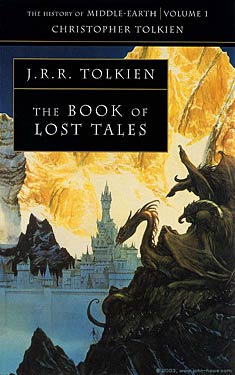JRR Tolkien, edited and commentary by Christopher Tolkien
Completed 7/25/2015, Reviewed 7/27/2015
4 stars
This was the title given by JRR Tolkien for a collection of
stories he wrote in the latter half of the 1910s. His original idea was to create a mythology
for England. It included elves which he
sometimes called faeries and gnomes, humans, gods, and other assorted
beings. He framed it in a larger story
of the first human coming to Tol Eressea which is inhabited by elves. Previously, only children came in their
dreams. They tell him their history and
he is overcome with wanting to be an elf himself. He stays on Tol Eressea and it eventually
becomes England. Tolkien abandoned the
project several years later, but it was not wasted. The stories evolved into what was eventually
published in “The Silmarillion”. This
book is a must for hard-core Tolkien fans, but it makes reading “The
Silmarillion” seem like a cakewalk.
I had a lot of difficulty with this book. The hardest part is the language. Tolkien writes in an archaic fashion. There are many words out of middle and old
English. For example, he uses “an” as
the article it is now, and also uses it with its old usage, meaning “if”. Instead of “diminish”, he uses “minish”. This gets quite confusing. Fortunately, Christopher recognized this and
included a short dictionary to translate these words. Between these words and the “Lo’s”, “thee’s”,
and reverse order sentences, you feel like you picked up a book written somewhere
between the Canterbury Tales and the King James Bible. On the positive side, I felt a sense of
mystery and wonder while reading it, but my train of thought often was derailed
by confounding sentences.
Another issue I had was that I still have “The Silmarillion”
familiarly fresh in my head. Since it
evolved from the stories in “Lost Tales”, I felt like I was reading an
alternative history of someplace I’m not from.
Sometimes the stories are roughly the same, sometimes not even close. The biggest difference is that here, the gods
have much more personality and interaction with the elves than in
“Silmarillion”. So one has to remember,
the Manwë here is not the same Manwë we’ve already met. And the action and motives aren’t the same
between the two books either. There are
some things that didn’t make it into the later mythology like the introduction
of Time, or how there came to be a man in the moon. But it’s all close enough that it can become
very confusing, assuming the archaic words and style didn’t already lose you.
The commentary for this book is quite extensive. Christopher Tolkien spends a lot of his time
explaining the differences between these stories and what became “The
Silmarillion”. In fact, one of the
reasons for presenting “Lost Tales” was a response to the critics that “The
Silmarillion” was more Christopher’s work than JRR’s. So when reading the commentary, he spends a
lot of time on the differences between the books, as well as inconsistencies
within. It must be remembered that “Lost
Tales” was eventually abandoned by JRR.
Knowing the kind of perfectionist he was, one can’t help but think that
he rolls over in his grave whenever someone cracks open this book.
Once again, I am grateful to The Tolkien Professor at
Mythgard Academy for the online seminars.
Following along in his lectures helps makes sense of the jumbles in my
head. I give this book an academic four
stars out of five. I highly recommend it
for the obsessed, or for those who want a challenging read, but if you’re just
looking for another Tolkien story, stick with “Tales from the Perilous Realm”
or “The Tolkien Reader”.

No comments:
Post a Comment